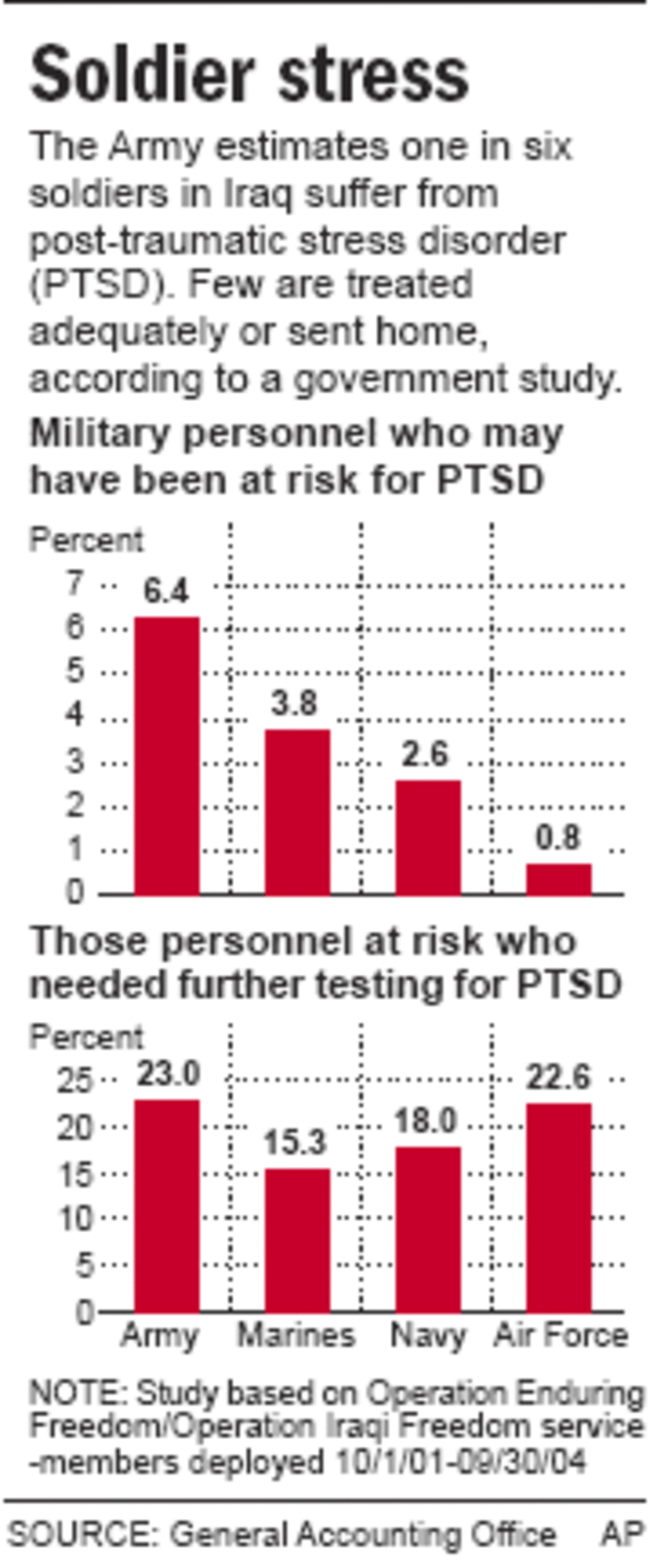An Army private charged with the slaughter of an Iraqi family was diagnosed as a homicidal threat by a military mental health team three months before the attack.
Pfc. Steven D. Green was found to have “homicidal ideations” after seeking help from an Army Combat Stress Team in Iraq on Dec. 21, 2005. Green said he was angry about the war, desperate to avenge the death of comrades and driven to kill Iraqi citizens, according to an investigation by The Associated Press.
The treatment was several small doses of Seroquel — a drug to regulate his mood — and a directive to get some sleep, according to medical records obtained by the AP. The next day, he returned to duty in the particularly violent stretch of desert in the southern Baghdad suburbs known as the “Triangle of Death.”
On March 12, 2006, Iraqi police reported a break-in at the home of a family in Mahmoudiya, about 20 miles from Baghdad. The intruders shot and killed the father, mother and two young daughters. The older girl, 14-year-old Abeer Qassim al-Janabi, was raped and her body set afire.
The carnage first was assumed to be the work of insurgents. That changed in late June when two members of Green’s unit told their superiors of suspicions that soldiers were involved in the killings. Now the Army believes Green and four other soldiers are responsible. One of them has confessed and provided information to prosecutors; in testimony at his court-martial, the soldier identified Green as the ringleader.
Military's worst-case scenario
If the charges are true, the attack would be among the most horrific instances of criminal behavior by American troops in the nearly 4-year-old war. It also would represent a worst-case scenario for the military’s much-criticized practice of keeping mentally and emotionally unfit personnel in the killing fields of Iraq.
Col. Elspeth Cameron Ritchie, psychiatry counsel to the Army surgeon general, would not specifically discuss Green when contacted by the AP. She defended the military’s policies regarding the treatment of emotionally or psychologically distressed soldiers.
“If unresponsive to treatment and/or a persistent danger to self or others, they will be evacuated,” Ritchie told the AP in an e-mail.

The 101st Airborne Division also declined to comment, noting it is an open federal case.
The Army and the Marines, who have the most personnel on the ground in Iraq, have been faulted for the manner in which troops with mental and emotional difficulties are being treated.
Sending troops already in Iraq who have been diagnosed with mental illness back to combat duty — often under medication that has not been prescribed long enough to have provided relief — has been a particular criticism.
Green has been charged with the murders and rape and pleaded not guilty in federal court in Kentucky. He is being tried in federal court because his arrest came after he had been discharged from the Army. Three others face the same charges and will be court-martialed.
Diagnosis details
From interviews with people who spoke on condition of anonymity because they were not authorized by the military to discuss the case, and from viewing the Army’s medical and investigative records, the AP also has learned:
- Three months passed without Army doctors and clinicians from the Combat Stress Team having any contact with Green. He was summoned for a second examination on March 20, 2006 — eight days after the killing of the family. Green was diagnosed as having an anti-social personality disorder and declared unfit for service. The process of discharging him began a week later, and he was sent home.
- The Army’s own investigation of Green’s initial treatment, prompted by concerns he and others would use mental health problems as a defense in trial, is highly critical. Among the most salient findings from a July review of Green’s treatment: “Although a safety assessment was conducted, there is no safety plan addressing how Soldier (Green) will keep from acting on his homicidal thoughts.”
- Lt. Col. Elizabeth Bowler, a psychiatrist and Army reservist from California who took over the Combat Stress Team with Green’s unit in January, recommended his discharge after the second examination in March. Yet she wrote a final evaluation that said Green exhibited no traits that would indicate dangerously erratic or homicidal moods, according to documents viewed by the AP.
Checkpoint incident
Green deployed to Iraq in September 2005 from Fort Campbell with a battalion from the 101st Airborne Division’s 502nd Infantry Regiment. The unit was charged with security operations and assisting Iraqi army units in the “Triangle of Death.”
Eleven days before Green’s first visit with the stress team in December 2005, he and five others were manning a checkpoint when an Iraqi civilian approached, according to testimony in military hearings. The civilian was familiar because of his status as a sometimes informant. He greeted the soldiers warmly before pulling a pistol from his belt and shooting two of them at point-blank range.
Green’s behavior worsened after that, according to commanders. He was directed to visit doctors a second time. Eight days later, Bowler told commanders that Green was unfit for service, according to documents. The discharge process for Green concluded in May 2006.
New Pentagon guidelines
The Pentagon issued new guidelines in November that prevent personnel with certain pre-existing mental problems from deploying to Iraq or Afghanistan. Clinicians evaluating whether a soldier in Iraq or Afghanistan is fit for service are now required to review all medical records. Mental illnesses that are not expected to be resolved in one year will be cause for discharge.
The Army’s hearings on the family’s murder concluded in August. Those who testified put forth this outline of the crime:
The plot to rape and kill was hatched as the soldiers hit golf balls at a checkpoint. They had seen the older daughter on patrols in the area. After drinking whiskey bought from Iraqi policemen, they masked their faces and crept through backyards in afternoon daylight to get to the family’s home.
They knew the family kept a gun in one bedroom for protection.
How it unfolded
Once in the house, Green herded the father, mother and 5-year-old daughter to another room, closed the door and shot them dead. Green had blood on his clothes and boots when he returned.
Green and at least two others took turns raping the other daughter before killing her with the family’s AK-47. They set her body on fire with kerosene dumped from a lamp in the kitchen in an effort to hide evidence.
Green is in custody at an undisclosed location in Kentucky, according to federal law-enforcement officials. Prosecutors have not said if they will seek the death penalty.
Pfc. Jesse V. Spielman, 22, of Chambersburg, Pa.; Sgt. Paul E. Cortez, 24, of Barstow, Calif.; and Pfc. Bryan L. Howard, 23, of Huffman, Texas, have been charged with rape and murder and await courts-martial. They are in custody at Fort Campbell.
Spc. James P. Barker, 24, of Fresno, Calif., pleaded guilty in November as part of an agreement to testify against the others.
